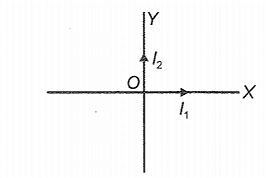A cyclotron cannot be used to accelerate
1. Deutrons
2. Protons
3. Neutrons
4. Both (1) & (3)

1. \(\mu_{0} i_{1} i_{2}\)
2. \(\dfrac{\mu_{0} i_{1} i_{2}}{\pi}\)
3. \(\dfrac{\mu_{0} i_{1} i_{2}}{2 \pi}\)
4. \(2 \mu_{0} i_{1} i_{2}\)
Two long straight conductors with currents are placed along X and Y-axes. The locus of points of zero magnetic induction is

1. A parabola
2. A rectangular hyperbola
3. A straight line
4. An ellipse
Cyclotron frequency does not depend upon
1. Specific charge
2. Speed of revolving particle
3. Magnetic induction
4. Charge
The maximum kinetic energy of an coming out of a cyclotron accelerator is 20 MeV. The maximum kinetic energy of a proton that can be obtained from this accelerator is
1. 20 MeV
2. 40 MeV
3. 10 MeV
4. 5 MeV
In a moving coil galvanometer, magnetic fields line by magnet are made
1. Uniform
2. Concentric
3. Helical
4. Radical
A wire abcdef with each side of length L bent as shown and carrying a current I is placed in a uniform magnetic field B parallel to the positive y-direction. What is the magnitude and direction of the force experienced by the wire?
1. BIL along +z-direction
2. BIL along +y-direction
3. BIL along -z-direction
4. BIL along -y-direction
The current sensitivity of a moving coil galvanometer is \(1~\text{rad /A}\) and its resistance is \(5~\Omega\)
1. \(0.2~\text{rad/V}\)
2. \(0.1~\text{rad/V}\)
3. \(1~\text{rad/V}\)
4. \(2~\text{rad/V}\)
Torque on a current-carrying coil is maximum in a uniform magnetic field, when
1. Plane of the coil makes an angle with the field
2. Plane of the coil is perpendicular to the field
3. Plane of the coil is parallel to the field
4. Plane of the coil makes an angle with the field
In which of the following situations will there be no force?
1. A positive charge projected past a bar magnet
2. A positive charge sent along the axis of a solenoid
3. Two parallel wires carrying current in the same direction
4. A positive charge projected between the poles of a magnet







